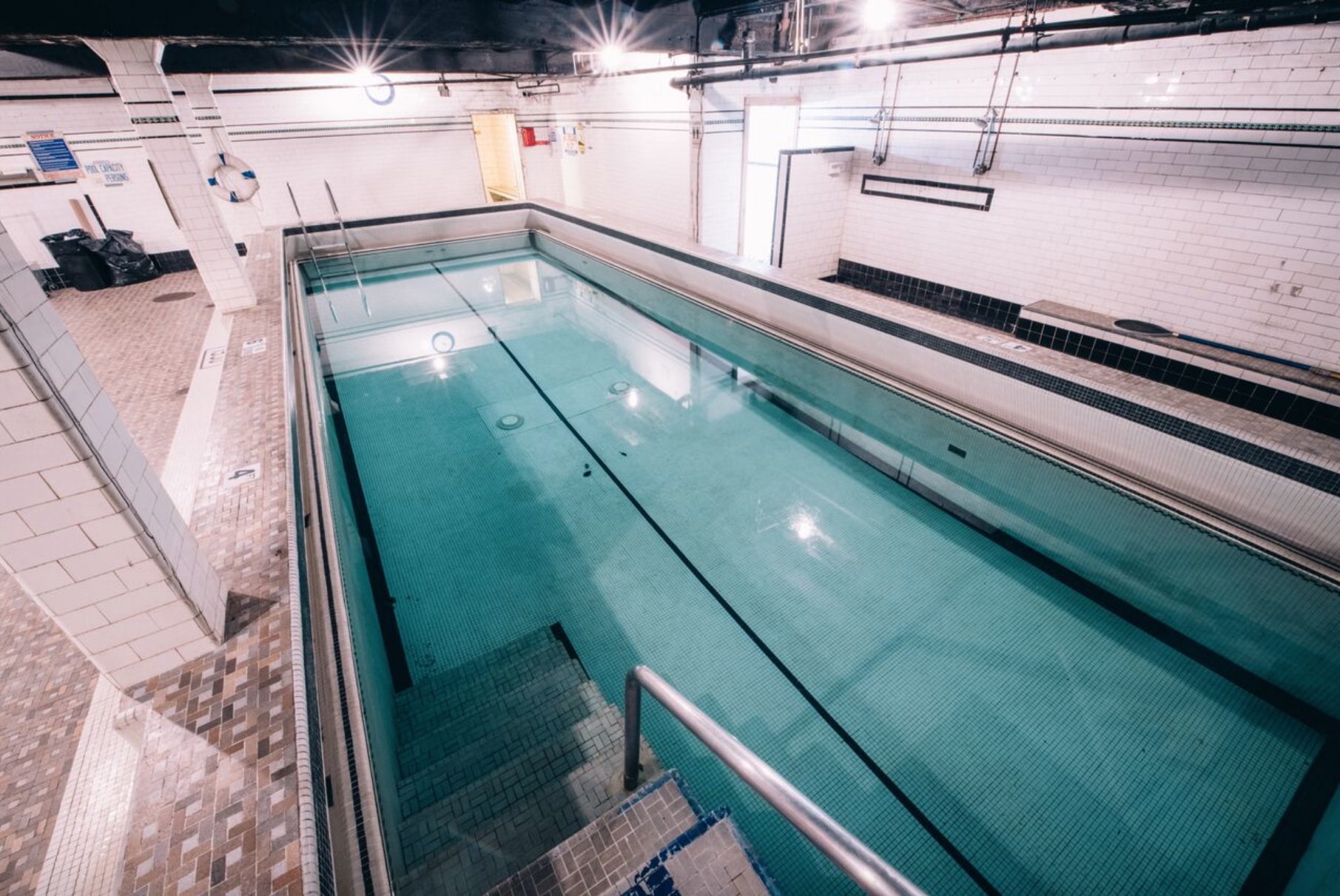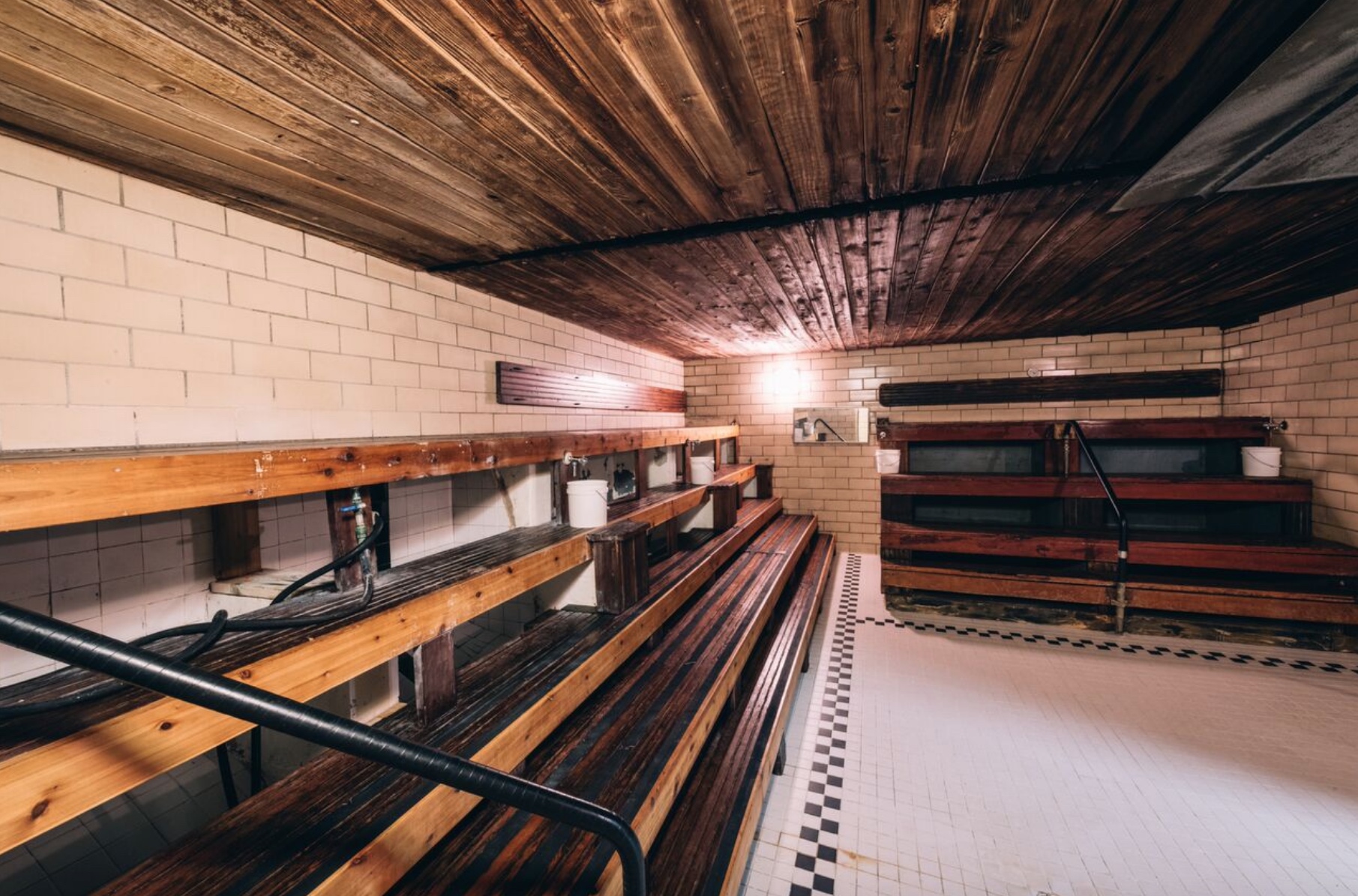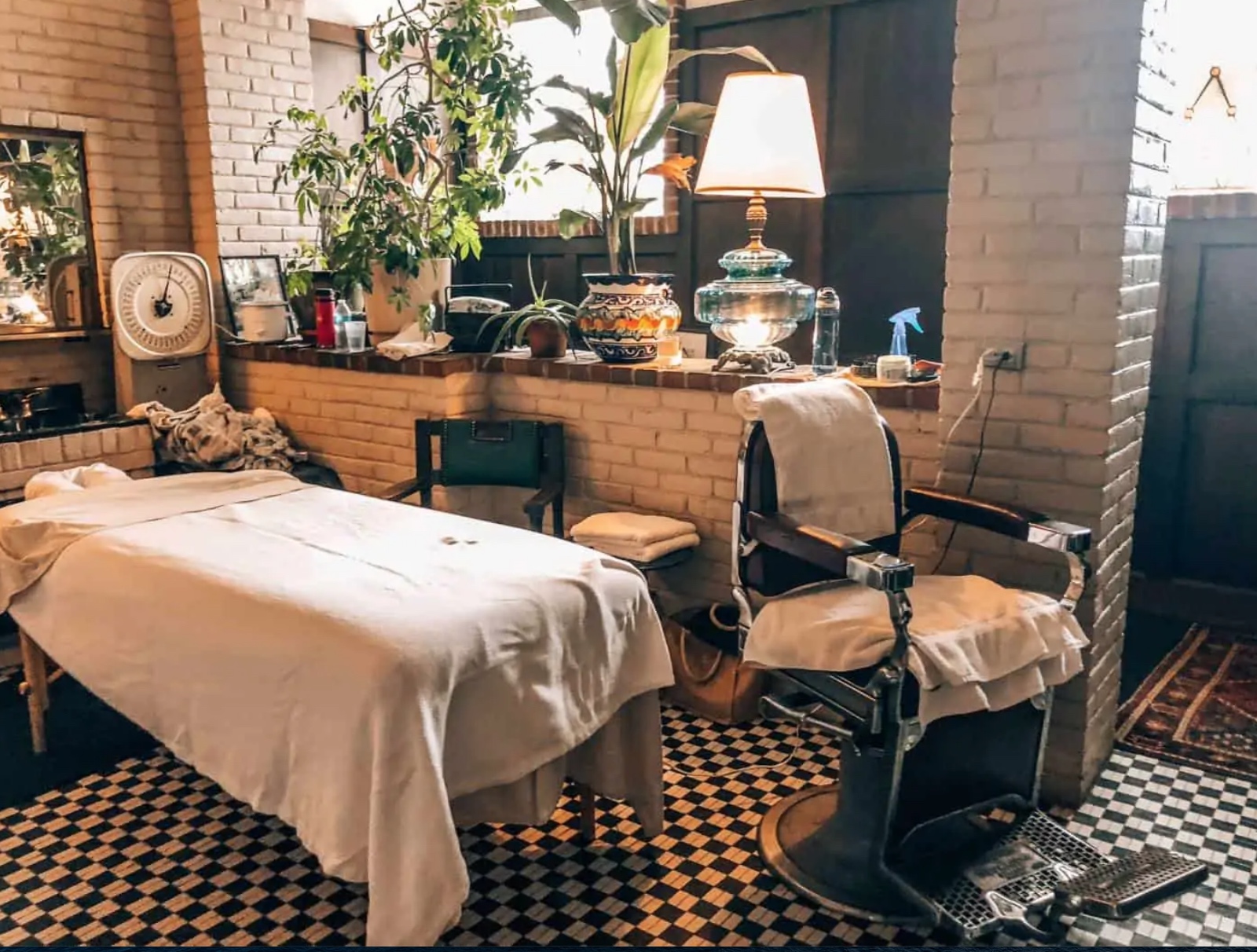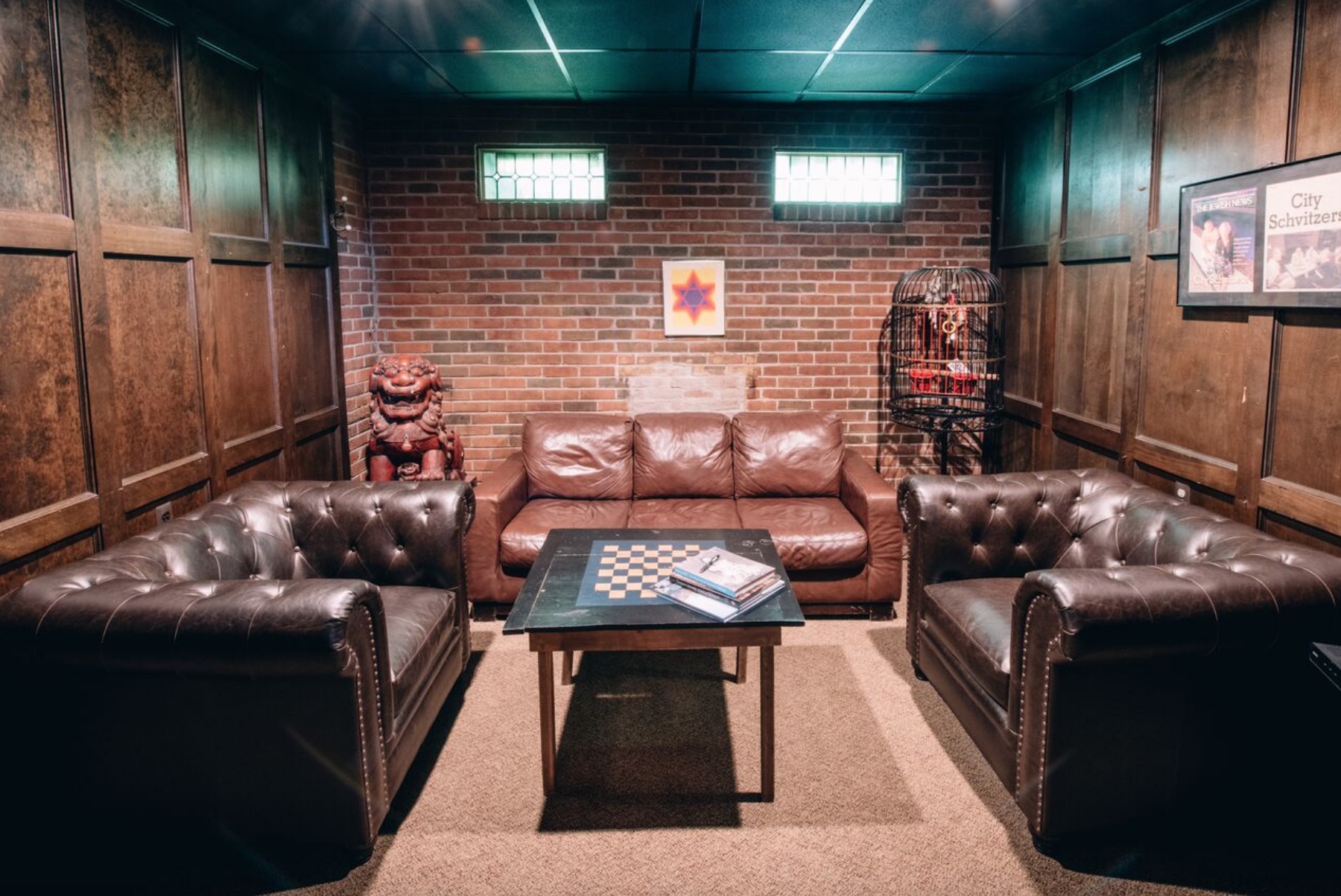The Transformative Power of the Schvitz
Gallery

My earliest memory of taking heat in a sauna goes all the way back to my childhood days growing up in New York. The Jewish Community House where we lived in Bensonhurst, Brooklyn, had an enormous steam room which my dad and granddad regularly visited. They always brought my brother and me along as they chatted it up with their friends in the dripping heat. We were very young back then and had no idea of what the sauna represented to this dedicated group of men that congregated every week at the JCH. All we knew was that it was a community center and super fun to run around the place as kids. The heat was always there but we never really paid much attention to it.
It was nearly 40 years since I’d been in a traditional sauna when I first stumbled upon the Schvitz Health Club in Detroit. My friend Robin Scoville had been bugging me to “Come take some heat at the Schvitz!” for about a year and a half, but to no avail. I was deeply immersed in a community project that took up most of my time, and I was seriously struggling with some mental health issues. The last thing I wanted to do was be around a lot of people, much less a lot of sweaty, NAKED people! Robin eventually invited me to a birthday party he was having there and once I arrived it was like coming home. The sense of camaraderie was almost palpable the minute I walked through the door and ironically enough being around a bunch of naked sweaty people had the exact opposite effect on me that I thought it would. Instead of feeling self-conscious about my body and my nakedness, I felt liberated and completely free. In the sauna there is no shame.
Gary Sosnick’s website devoted to the history of the Schvitz explains that it was originally called the Oakland Baths. Now called the Schvitz Health Club (voted 2nd best in Detroit by Hour magazine), the unassuming brick building sits on the corner of Melbourne Street and Oakland Avenue. Situated in Detroit’s North End, this has been a place where people gather to take heat, unwind and socialize for close to a century. The Schvitz, which literally means “sweat” in Yiddish, is a perfect example of how a place can foster and build community while providing a spatial anchor for people to connect with the past. It was built in 1917 and initially a Jewish Community Center, very similar to the JCH of my childhood. The early part of the 20th century saw a significant influx of immigrants arriving from Eastern Europe and they formed a strong presence in the North End, helping to populate the assembly lines of the burgeoning auto industry. An immigrant Jew born in Russia, Charles Meltzer took ownership of the building during the beginning of the Great Depression and began making the bathhouse in the predominantly Jewish North End. The pool in the basement was hand dug by a local man named Eugene Johnson, affectionately known by many as “Toots.” Back then you could get a bar of soap, a towel, and a bed for just $1 and much of the housing in the area consisted of cold-water flats, so this was particularly useful to residents during the coldest months.
Mobsters, politicians and blue-collar workers all congregated together peacefully to take heat in the sauna. Today it is very much the same, although modern day mobsters are probably more discreet. This is likely because the place was under federal surveillance due to suspected illegal activity in the 70’s and 80’s. The deindustrialization of Detroit led to a sharp decline in the city’s population, and the Oakland Baths suffered, causing it to change ownership numerous times. It was even a swingers’ club for a number of years until the most recent purchase and renovation that has restored the Schvitz to something more closely resembling the past. “In the sauna everyone’s the same,” claims Paddy Lynch, the current owner, or “caretaker,” of the place as he likes to say. As a fourth generation undertaker with decades of service to metro Detroit, his connections to the local community run deep. His first visit to the Schvitz was with a close friend, and it was love at first sight. He discovered an extended family that provided a level of camaraderie and emotional support that helped him emotionally, as well as psychologically. Almost a decade later the opportunity to purchase the building presented itself, and Lynch jumped in with both feet.
The important thing to remember about the Schvitz when speaking in the context of places, and placemaking in general, is that it becomes a place for people to gather and share experiences. A place where the sum of the whole is much greater than the individual pieces grouped together. It doesn’t matter if you arrive in a Porsche or by bicycle, the banya (another word for the traditional Russian-style sauna) becomes the great equalizer and the heat is part of the reason why. The heat doesn’t care if you are rich or poor, black or white, Christian or Jew. Fire is universal. As a funeral director, Lynch knows the importance of this and goes to great pains to ensure that everyone feels safe and welcome once they enter the front door.
Lynch says, “Dima likes to say this place is maternal,” referring to our friend who goes by only his first name, Daniel, the Russian born Olympian who has been overseeing maintenance and operations of the banya for nearly 50 years now.
Acknowledging the feminine side of the banya only further illuminates Lynch’s desire for providing safety and inclusivity. Once a place open to just men, women-only hours are part of the regular schedule now, and recently the ladies have been asserting themselves in a space that men have been jealously guarding for decades.
Sunday is my absolute favorite day to go “schvitz.” The best heat is during the dead of winter when it’s 10 below zero and there’s a foot of snow on the ground. Dead streets greet you at 7 a.m. on a Sunday morning in Detroit, especially in February. But there is life in the banya. I love the crunching sound the tires make as my truck rolls to a stop in front of the building. The snow acts like soundproofing, and absorbs most of the usual background noises. Quiet stillness creates a holy silence, making the experience almost church-like. There is an old Finnish saying, “saunassa ollaan kuin kirkossa,” - one should behave in the sauna as in church - and these moments remind me of this aphorism. The humid warmth inside the building immediately envelops you upon entering the front door, the dark rich paneling on the walls exuding character and hinting at layers of thick history.
Only the dedicated few will show up regularly that early. It’s a diverse and rather motley crew that congregates on Sunday mornings, and we are all brothers in the banya. It doesn’t matter that we don’t hang out with each other outside of the club. What matters is the heat, and on Sunday mornings the hotter the better. It’s almost as if we purge ourselves of the week’s filth in a communal offering and this sense of brotherhood, although strong, is difficult to articulate. It is the essence of community placemaking in a very intimate setting and part of what defines the traditional banya experience. There are lessons to be learned in the banya, and time slows down there. As Alan Havis, a 50-year veteran of the Schvitz likes to say, “The heat doesn’t change. It’s how we respond to it that matters.” It is inside these little nuggets of wisdom that real treasures are found. Buried inside these treasures are all of the lessons we need to know about life. We just have to look for them.
Yiddish for shoulders and back, platza is a term used to describe a traditional Russian ritual performed inside the banya. Usually administered by more experienced schvitzers, the platza is a ceremonial scrubbing with a venik (a bundle of young white oak or birch leaves tied together to form a hand broom). Some people use soap during the platza – I’ve been told that Ivory soap is what to use – and will wash you from head to toe, gently massaging the intense heat deep into your muscles while simultaneously exfoliating and rejuvenating your skin. It’s very intimate in a nonsexual way, and many people claim they enjoy giving them almost as much as getting them. The intrinsic act of giving with no intention of reward is what makes the platza so special, and provides a mechanism for building and sustaining interpersonal relationships.The health benefits are numerous and well documented, although most of the information I’ve been able to find pertaining to this ritual scrubbing is anecdotal and subjective at best. The tannins and essential oils released from the white oak leaves are well known to provide relief for arthritis, colds, cough and bronchitis and this may explain why I haven’t gotten the flu or even a cold since I started going there almost four years ago. My first experience receiving a platza was amazing, and I got triple teamed by three veterans of the banya who gave it to me “raw dog,” a term used to describe the more traditional style which is performed without soap. They rhythmically beat me with those brooms, selflessly enduring the intense heat while massaging my back and shoulders with unexpected tenderness. Completely refreshed and invigorated, my steaming, freshly exfoliated skin tingled as I stepped into the cold plunge pool, hand dug by Toots 92 years ago. It was a spiritual moment and made me want to be a part of this loving community.
“The oven in the basement is undeniably the beating heart of this place,” says Lynch. The walls are over a foot thick and with a generous application of high temperature refractory clay lining the interior, this ain’t no pizza oven! Four gas fired burners provide close to 1 million BTUs of energy. Ancient, but still very functional, these torches heat up more than 7 tons of field stones contained within the massive oven and once they are glowing this beast will provide intense, bone-warming heat all day and night. If the oven is the heart, then the rocks are the lifeblood. With some weighing more than 30lbs, these large rocks are thoughtfully arranged each year as they are replaced, one by one, in a very ritual form of bonding that is referred to as the changing of the rocks. I like to think of this as a selfless act that we do for one another. Usually, a group of 10-20 dedicated schvitzers will show up to help.
The rocks we replace on that hot summer day each year will provide thousands of hours of blessed heat throughout the coldest winter months of the Mid-Northwest for people we don’t even know - people who may never have experienced the banya before. It’s great to watch someone enter the sauna for the first time and see their reaction to the heat. Knowing that you had a hand in making it possible for them to experience it is part of the magic, the selfless aspect of it. As all of the energy contained within those rocks is released, energy that was imbued with every hand that touched them, a connection is made through time and space with the ancestors who first showed us the power of fire, heat, and community. This transference of energy is the thread which gets woven into the fabric of the sauna community. It becomes a link to the past which transcends creed or color, and connects us all to one another through the elemental force of intense heat. It is the essence of sauna culture.
The symbiotic relationship formed by the place and the people, in the case of the Schvitz, is a delicate balance indeed. One cannot exist or function without the other. Without the people the banya does not exist. it is just an empty shell full of potential energy. Likewise, without the banya to provide a communal space where all are equal in front of the heat, the sauna culture does not exist. Like my friend Carmelo Gonzalez, current manager of the Schvitz, likes to say, “Just as the fingers of each hand work to form and shape the clay, so do the different people who make up the regular crew at the Schvitz shape this place.”
The transformative power of heat energy is evident in nature. We see it in raging forest fires and explosive volcanic eruptions. It has the power to transform humanity if we let it, and therein lies the rub. When properly harnessed, this transformative energy derived from heat can change perspective, and in doing so has the power to change people’s lives. This simple act of self-care becomes a quiet act of rebellion within the hallowed walls of the banya. We encourage one another in the spirit of humanity to remember the importance of community, and service to others. With reverence and dignity, we are able to care for each other in spite of all the trouble and hardship we face in the world today. Individual differences don’t matter when it’s 200 degrees. Everyone is just focused on dealing with the heat.
The banya offers a brief respite for the person weighed down by the monotony of our mundane existence. The steady grind of the 9-5 is softened somehow by the heat, and the knowledge that we are not alone in our day-to-day struggles. “Grief shared is grief diminished,” said Lynch during our interview. I’m sure it’s a phrase he uses often in the mortuary business.



